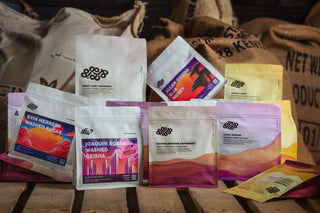Baristas from all around the US came to Topeka to compete in this event. Each barista was randomly placed on a team that competed in three separate scored events, each event would be considered in the overall Championship evaluation. This was a mix of some of the main coffee competitions in the industry, and differed from the official World Barista Championships by being a team competition, as well as the incorporation of multiple scoring events. I thoroughly enjoyed the novelty and integration of industry relevant skills that this competition had.
The first event consisted of a triangulation cupping. There are eight stations here, with each station comprising of three cups of brewed coffee. The catch is, two of the cups have the same coffee while one is different. Competitors have to differentiate which cup is the unique one, as quickly as possible. Scores here are given first for accuracy, then for the completion time. This is modeled after the World Cup Tasting Championships.
Next was a latte art throw down, which is probably the most exciting and engaging event for both competitors and the public. This event is simple: all the competitors are organized in a tournament-style, single-elimination bracket. Baristas competed head-to-head, each of them pouring their best latte art in a 6 oz cappuccino cup. Winners from each round advance further, and the remaining people are eliminated immediately. Alejandro, Pete and I had a lot of fun judging, which just involved all of us pointing to the winner on a count of three. After the main competition, there was a casual buy-in competition for anyone to participate in – Pete, Alejandro and I joined. I had not been in a latte art competition for a long time, so it was fantastic being right in the center of it all. Unfortunately, I was ousted in the semi-finals, but Alejandro avenged us by taking the prize money. This was a terrific night – live music, great beers being poured, and a lot of coffee people getting to know each other.
The final event on the last day was the most important one. In the morning, groups had a chance to taste several different coffees with different roast “levels”. In their groups, they spent the afternoon crafting, tasting and tweaking their own custom espresso blend. While we do not blend at Phil & Sebastian, it reminded me of similar challenges we have with presenting espresso – balance and flavour. Some of the coffees had huge fruit flavour yet were wildly acidic while some had great body yet lacked sweetness. The challenge of the groups was to be able to choose specific coffees, roasts and proportions to create a blend that represented a theme that they could present to us judges. Throughout the day, teams also had the opportunity to meet with the producers, or Pete, Alejandro, and myself to gain more insight into the coffees and how to craft a competition routine.
At the end of the day, was the culmination of all this hard work: the presentations. The score sheet was an adaptation of the World Barista Championship’s sensory score sheet. Each group had 15 minutes to present to six sensory judges an espresso and cappuccino each; all while presenting their blend, rationale and process for creating it, and working harmoniously within their group. I was amazed at the quality of presentations and the uniqueness of the themes and tastes of the coffees. The blends ranged in taste from being intensely fruity and acidic, to rich and chocolatey. Everyone had a unique combination of coffees and a great rationale. They were also able to convey a lot of farm and processing information that was inspired from talking with the producers. We even had groups prepare chemexes tableside or get us to transfer and evaluate the aromas of the espressos. The team synergy was another unique part of this competition; this team dynamic was a new experience for me and something I enjoyed. I love going to a new cafe and observing the workflow efficiency, and judging the team synergy was no different. If anything, this competition most closely emulated a real cafe environment, and forced groups to evaluate how to use their individual strengths effectively. We ended off the competition with an awards ceremony and closed off the competition by celebrating at a local brewery.
Flatlanders 2012 at PT’s Coffee was a fantastic experience. Aside from meeting incredible people from around the globe, and experiencing some fantastic presentations, one of my favorite parts of the weekend was seeing the Midwest US coffee community grow, bond and continue to thirst for more learning. I saw many baristas who were just starting in the industry, they were wide-eyed as they soaked everything in and it was clear they loved every moment of the weekend. In an industry that can often be overcritical, it was refreshing to see a new community grow and discover coffee together. The Midwest is undeniably on its way to creating a prominent place for coffee, and the exciting thing is everyone is helping to build and push it forward together. That is something I am truly passionate about and was so happy to experience it in person at Flatlanders 2012!
Thank you all for having me there!
Jeremy Ho
2012 Canadian Barista Champion







